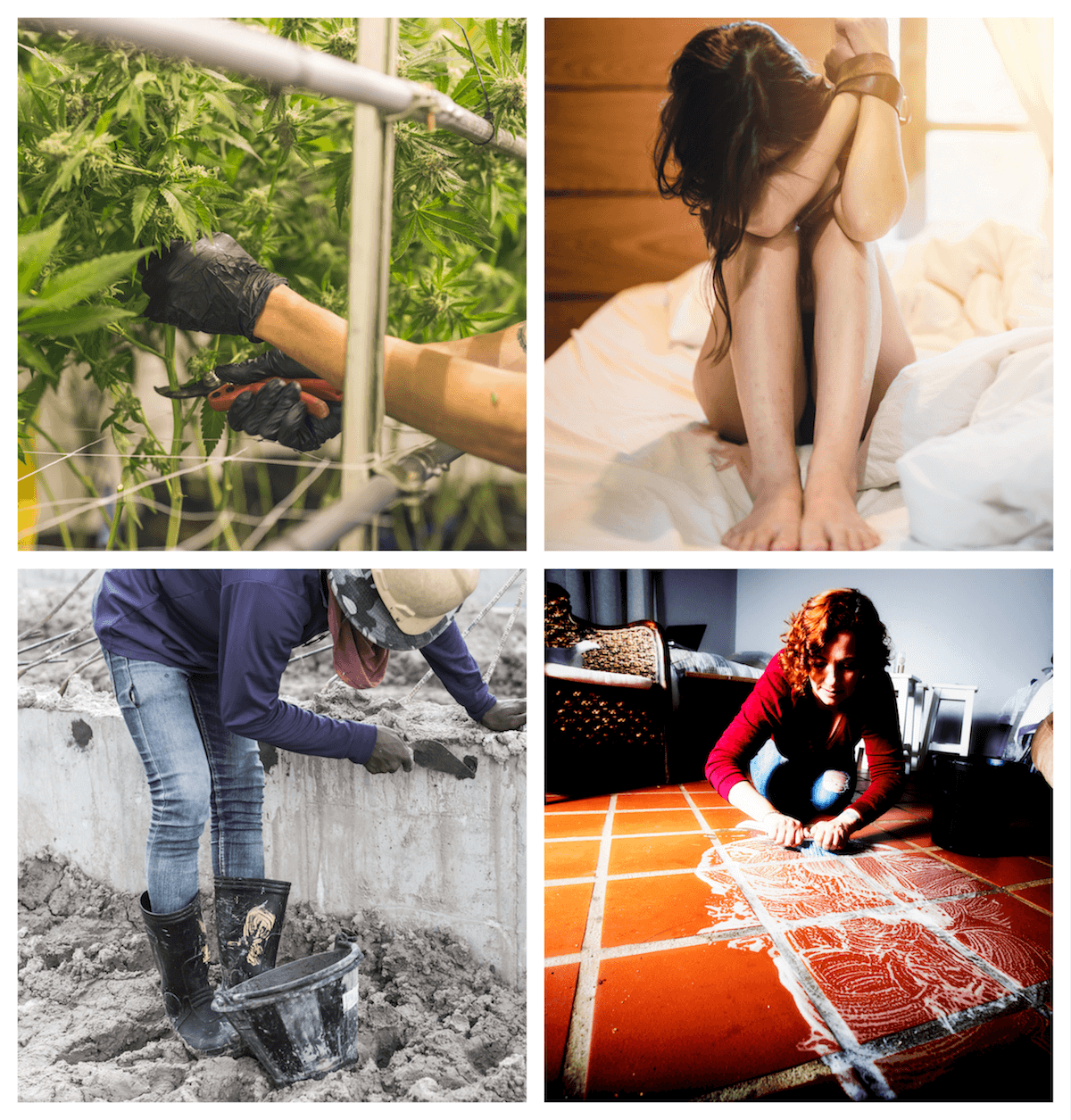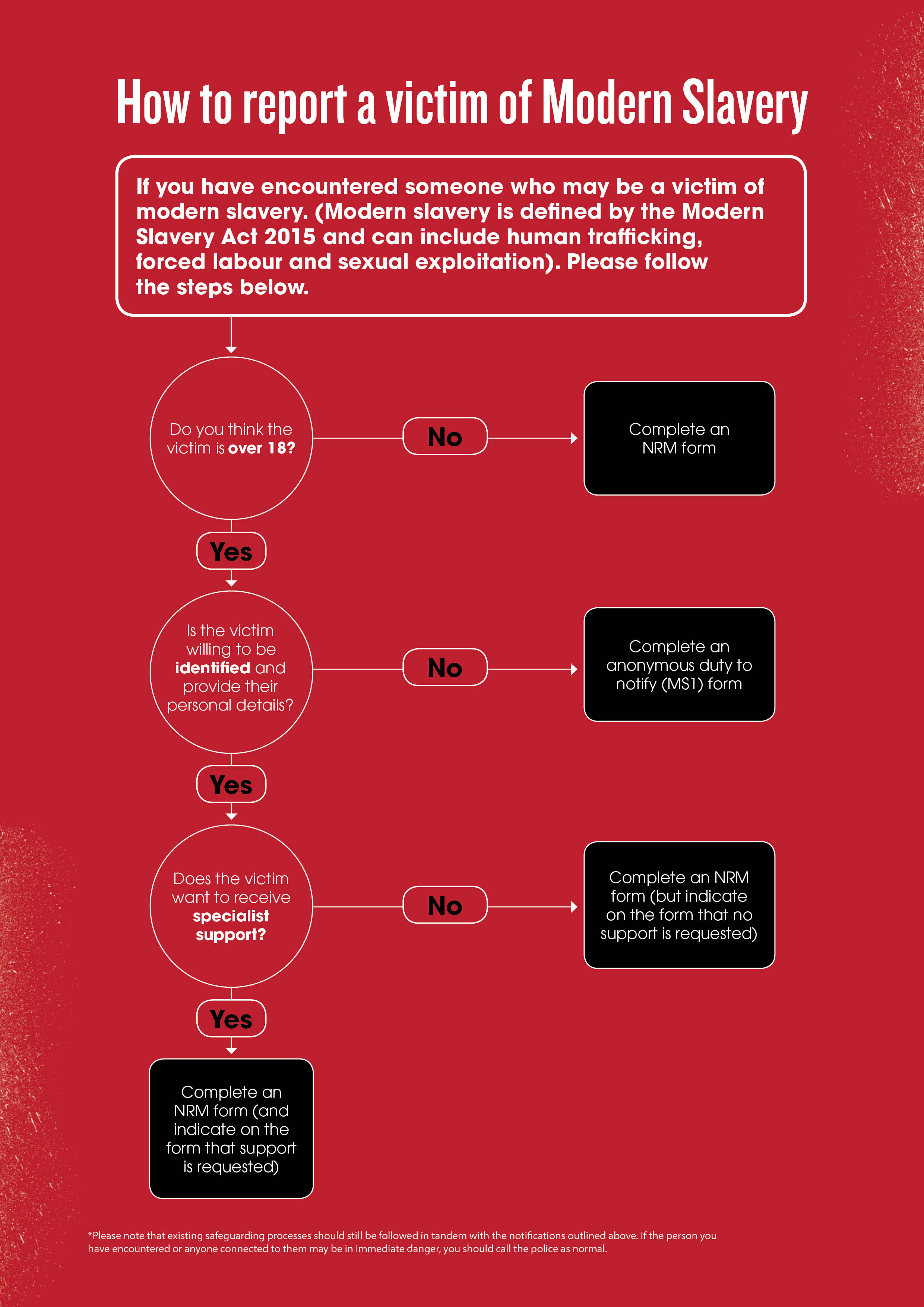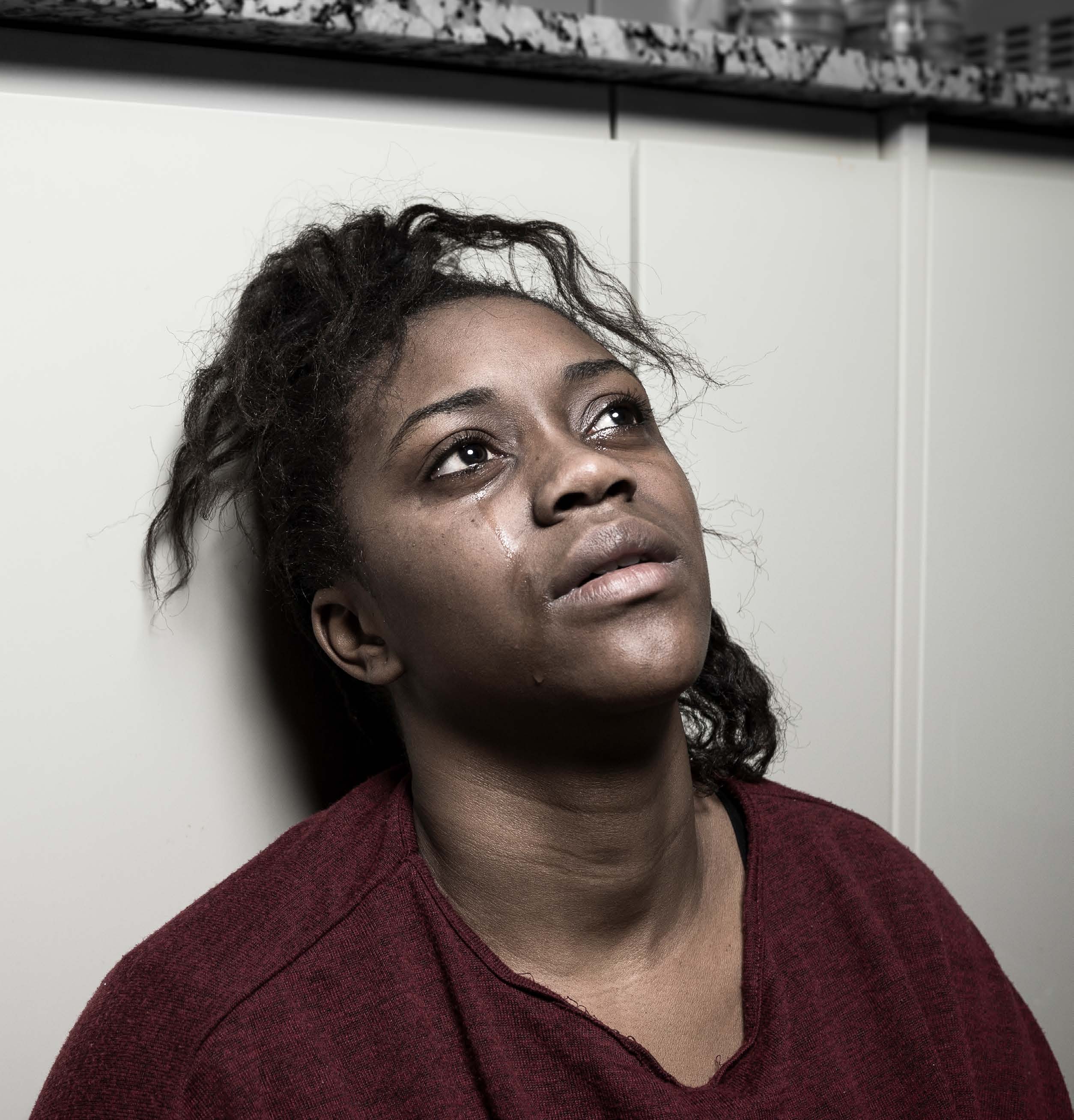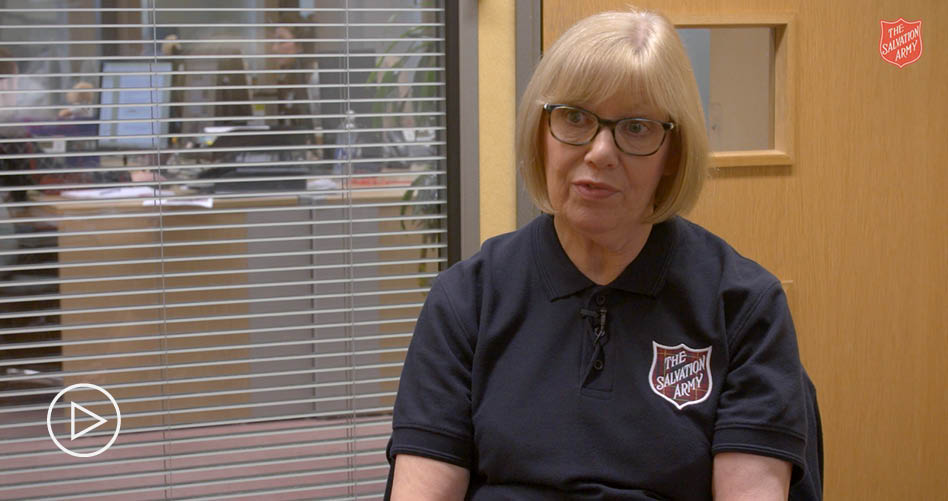Aim: To ensure that as a social worker, you are able to:
- Confidently spot the signs of someone who may be living in domestic slavery
- Know the appropriate course of action to take to get a suspected domestic slavery victim much-needed support
Learning outcomes/objectives
- To learn how to spot the signs of a potential domestic slavery victim
- To know the process of reporting to use if you suspect someone is a domestic slavery victim
- To be aware of the support available to domestic slavery victims
The role of social workers
Your role as a social worker is important to victims of modern slavery, especially domestic slavery. This is because unlike many other professions, social workers are usually allowed into people’s homes which can give them better insight into a person’s circumstance. Asking where people sleep, where they keep their belongings and what their daily routine is like, can seem like general professional curiosity but it can give you very clear information about whether someone is the victim of modern slavery.
| Before you begin this module, please rate yourself on the following: | Strongly Disagree 1 |
Disagree 2 |
Neutral 3 |
Agree |
Strongly Agree |
|---|---|---|---|---|---|
| I am confident in spotting the signs of a potential domestic slavery victim. | |||||
| I am confident in knowing the most appropriate course of action to take after identifying a domestic slavery victim. | |||||
| I am confident at knowing how to report someone I suspect of being a domestic slavery victim | |||||
| I am confident at identifying the range of support options available to domestic slavery victims. |
The Home Office published “A Typology of Modern Slavery Offences in the UK” which is intended to improve awareness and understanding of the multitude of situations where someone may be being exploited as a victim of modern slavery.
The typology lists 17 different types of exploitations which can broadly be organised into 4 categories:
- Labour Exploitation
- Servitude (also known as Domestic Slavery)*
- Sexual Exploitation
- Criminal Exploitation

*The terms ‘domestic slavery’ and ‘domestic servitude’ are often used interchangeably in modern slavery materials. This is because domestic slavery is more widely recognised by the UK public while servitude is the technical term used in texts such as, the Modern Slavery Act (2015).
In this e-learning module we’re going to focus on domestic slavery. This form of slavery often goes unnoticed as victims and perpetrators can be difficult to identify. However, as social workers you have unique opportunities where you may come across it in your day to day roles.
Domestic slavery specifically relates to an individual who acts as a ‘live-in help’ in the home of their ‘employer’, but suffers exploitation within this environment.
Victims can be made to work excessive hours, deprived of food, water, and sleep, and abused – both physically and emotionally. They are isolated from their families and kept away from other people. Even when completing chores outside of the home, threats and fear keep them from
speaking out or escaping. Typically, domestic slavery victims feel they have no one to turn to for help.
In many West African cultures, especially Nigerian, it is considered the norm to have a ‘house help’ (sometimes referred to as, ‘omo-odo’) and in some cases a victim’s ‘employer’ may even be a relative. Unlike trafficking for sexual exploitation, forced domestic labour is more likely to be unrecognised or accepted in the local community.
The practice is often linked to child fostering and the promise of a ‘better life in the UK’. However, while it may start out as a positive reality, for many, their employment is set up with no regard for UK law or basic human rights.
The following are just some of the things that can happen to someone working as a domestic slave in the UK:
- Beaten/sexually abused by employer
- Given little to no food
- Threats made against victim and their family back home
- Passport taken away
- Not paid any money/or very little payment
- Not allowed contact with family back home
- Given limited contact with others in the local community
- Treated differently to other family/household members
- Forced to work for very long hours with few or no breaks
In 2014 the Home Office proposed that there were between 10,000 -13,000 potential victims of modern slavery in the UK in 2013.
However, the complex and hidden nature of modern slavery – and by extension, domestic slavery – makes it difficult to measure accurately. Professionals may struggle to identify victims and victims may be too traumatised to report their suffering even when given the opportunity.
In 2017 Local Authorities made 789 referrals of cases of suspected modern slavery to the National Referral Mechanism (NRM), 15% of the total 5,145 referrals were received by the Competent Authorities.
Of those 789 referrals, 722 of them were for children.
Key terms
NRM: The National Referral Mechanism (NRM) is the system that identifies victims of modern slavery and provides them access to support. It was introduced in 2009.
Competent Authorities: In the UK, the two Competent Authorities are the National Crime Agency’s Modern Slavery Human Trafficking Unit (MSHTU) for EEA nationals and the NRM Hub in UK Visas and Immigration (UKVI) for non-EEA nationals.
Read Glory’s story:
Thirteen year old Glory* was trafficked to the UK from Nigeria by a woman who told her mother she could have a better life in London. In reality she was forced to work between 6am-9pm, and often beyond.
Glory was shouted at and beaten for incidents as minor as not realising her ‘Madame’ had finished her cup of tea. The frequency of the beatings increased as time went on. Sometimes Madame’s husband would visit Glory in the night and sexually assault her.

*Real name and photograph not used to protect victim’s identity. The Medaille Trust and Salvation Army.
Question:
If you came across someone in these conditions, what would you most likely do?
(as the most appropriate course of action)
NO
Answer:
- do not raise your concern with anyone accompanying the person
- think about support and referral
- think about safeguarding and safety
YES
Answer:
- if possible, try to find out more about the situation by speaking to the person alone and in private.
If you do, remember;
- the person may not self-identify as a victim
- reassure them that it is safe to speak
- ask non-judgemental relevant questions
- don’t make promises that you can’t keep
Victims may be reluctant to come forward with information or tell their stories with obvious errors. It is not a social worker’s role to interrogate the person on this. ‘Employers’ can sometimes give victims stories they have to tell if approached by the authorities, or victims’ accounts can be affected by the trauma they have experienced.
NO
Answer:
The community may not be able to provide appropriate support
YES
Answer:
If you’re concerned someone might be in a domestic slavery situation, trust your professional instinct and call one of the following:
- The police
- The Salvation Army referral helpline
- Unseen’s modern slavery helpline
Both helplines offer similar support to victims but are run by two different charities
YES
Answer:
If you’re concerned someone might be in a domestic slavery situation, trust your professional instinct and call one of the following:
- The police
- The Salvation Army referral helpline
- Unseen’s modern slavery helpline
Both helplines offer similar support to victims but are run by two different charities
YES
Answer:
In the first instance, if you find that urgent medical assistance (physical or psychological) is required, you should take immediate action to ask questions and get them the medical help that they need.
Once this is done, you can then start the process for them to be safely taken out of their domestic slavery situation.
YES
Answer:
Communication with colleagues is vital as they may have more experience in this area than you and/or can help you formulate your view.
Local safeguarding teams may also have a file open or prior knowledge/suspicions of the case which may expedite action.
Actions to take if you suspect someone
is a victim of domestic slavery

Regular communication with colleagues and local safeguarding teams on the issue is vital throughout and can prove extremely useful.
What is the duty to notify?
The Modern Slavery Act introduced the ‘duty to notify’ which has been in place since 1 November 2015. This requires specified public bodies such as Local Authorities (including social services) to report all adult victims (over 18) of modern slavery (including domestic slavery) to the government.
What do I do?
If an adult victim (over 18) does not consent to being referred to the NRM:
You must complete a Duty to notify (MS1) form instead, as you still have a duty to notify the Home Office that you have identified a potential victim of modern slavery. The victim’s details can be anonymous.
If a child victim (under 18) does not consent to being referred to the NRM:
An NRM referral should still be made, even if the child doesn’t consent, as you do not need consent to complete a referral for a potential child victim of modern slavery. An MS1 form, therefore, should not be completed.
What are the next steps of the NRM following a referral completed by a first responder?
When a first responder completes an NRM referral form, the Competent Authorities are then responsible for making a decision on whether that individual is or is not a victim of modern slavery. The Competent Authorities follow a two stage decision process:
Stage one – the NRM team aims to decide within five working days whether there is reasonable grounds to believe that someone is a victim of human trafficking or modern slavery.
Stage two – following a minimum period of 45 calendar days a ‘Conclusive Grounds Decision’ is made, the decision makers threshold for a Conclusive Decision is that on the balance of probability “it is more likely than not” that the individual is a victim of modern slavery.
Key terms
First responder: The name of the agencies (e.g. social services) who are authorised to make the initial modern slavery victim referrals to the two Competent Authorities.
Click here for more informationHow does the NRM support victims of modern slavery?
If the Competent Authority has reasonable grounds to believe someone is a victim, that individual is entitled to:
- A ‘reflection and recovery’ period (a minimum of 45 calendar days) of support, or until a conclusive grounds decision has been made. This allows the victim to begin to recover from their ordeal and to reflect on what they want to do next.
- Adult potential victims of modern slavery (over 18) are supported through Government-funded support, including services coordinated by The Salvation Army.
- Support includes: safe house accommodation, financial subsistence allowance, counselling, access to mental, physical and dental health services, and signposting to legal support.
- Child potential victims of modern slavery (under 18) are supported by Local Authorities.
Barriers to victims coming forward
Domestic slavery victims can often feel complicit in their exploitation or not see themselves as victims at all. This keeps them from reporting their situation to the appropriate services.
Even when this isn’t the case, the following factors can be barriers keeping a victim from reporting their situation:
- Fear of deportation
- Fear of punishment at the hands of their traffickers or authorities
- Shame or concern about discrimination from their community or families
- They see their current situation as temporary and blame themselves for not understanding the culture or labour market in the UK
- They may be dependent on their abuser
- Children from outside the UK may have a different cultural understanding of childhood to the UK and feel it is their responsibility to work
In situations where victims are unwilling or unable to come forward and the victim is over 18, objective signs (indicators) of domestic slavery and human trafficking need to be considered.
How to spot the signs of a potential victim of domestic slavery
Important questions to consider if you suspect someone is living in domestic slavery are:
Even when this isn’t the case, the following factors can be barriers keeping a victim from reporting their situation:
- Does their appearance suggest they are in need of sleep, food or medical care?
- Do they seem to be treated differently to other members of the family present?
- Do any younger children present seem overly confident in telling them what to do?
- Do they seem as though they can freely contact their friends or family?
- An unsupported fear of police or immigration authorities
- Do you know if their passport or any official documents have been taken away?
- Are their sleeping conditions concerning or significantly different to the rest of the sleeping arrangements in the home?
Other signs
Victims may present personal stories that are inconsistent or incorrect because they are traumatised or have been intimidated and coached on what to say by their abuser.
The circumstances in which you are able to talk to a victim can also be a red flag. For example, you may find that you are unable to access the victim alone.
Telling the story from a victim’s perspective, this short film Spot the Signs, shows how ‘Theresa’ was promised a better life in the UK but was instead exploited. When she arrived in the UK, the family she was staying with took her passport away, denied her an education and subjected her to abuse. She is rescued when a pastor at her church spots the signs that she is being held in slavery.
Question: What should you do?
If a suspected domestic slavery victim is over 18:
If you [social worker] wish to receive government support and the victim is happy to be identified you should complete an NRM form. However if they do not wish to be identified there is nothing you can do.
Correct
If a victim wishes to remain anonymous you should complete a duty to notify (MS1 form).
Inorrect
If a victim wishes to remain anonymous you should complete a duty to notify (MS1 form) as this form is intended to help build a more comprehensive picture of the nature and scale of modern slavery in England and Wales.
If a suspected victim is under 18:
Regardless of whether a victim is over or under 18 you [social worker] still need consent to complete an NRM form
Correct
If you suspect a victim of slavery is under 18 you do not need their consent to complete an NRM form.
Incorrect
If you suspect a victim of slavery is under 18 you do not need their consent to complete an NRM form.
| You’ve now reached the end of the module. In order to chart progress, please rate yourself again on the following: | Strongly Disagree 1 |
Disagree 2 |
Neutral 3 |
Agree |
Strongly Agree |
|---|---|---|---|---|---|
| I am confident in knowing the most appropriate course of action to take after identifying a domestic slavery victim. | |||||
| I am confident in spotting the signs of a potential domestic slavery victim | |||||
| I am confident in knowing the most appropriate course of action to take after identifying a domestic slavery victim. | |||||
| I am confident at knowing how to report someone I suspect of being a domestic slavery victim. | |||||
| I am confident at identifying the range of support options available to domestic slavery victims. |
How to report a victim of Modern Slavery
Click on the image to view our infographic on best practice to report a victim of Modern Slavery.

Useful resources
Thank you for completing this module. The following list of resources cover the information you’ve just been taught and include some quick links to the important forms mentioned:
https://www.antislavery.org/slavery-today/modern-slavery/
HM Government 2017 Annual Report on Modern Slavery October 2017
Modern Slavery typology research report (pages 19 to 24)
http://www.nationalcrimeagency.gov.uk/about-us/whatwe-do/specialist-capabilities/uk-human-trafficking-centre/national-referral-mechanism

